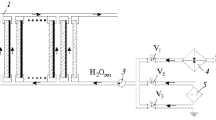Abstract
A new and effective seafloor geodetic observing robot network system, which consists of several submarine stations situated in regions susceptible to interplate earthquakes, has been proposed and is under construction in Japan. Each station, equipped with an autonomous underwater vehicle (AUV) dock, is connected to a land facility by cables providing power and communication. Near the AUV dock, three or four seafloor reference stations will be set up for geodetic observations. In this system, a noncontact power supply is required for a battery-driven AUV to conduct observations for extended durations. A small, intelligent, efficient, high-power noncontact feed system of 400 W capacity with an inverting efficiency of 77% in salt water has been developed. It has been shown to be effective in a water tank experiment in which the noncontact power supply automatically fed power to an AUV for 3 days.
Similar content being viewed by others
References
A Asada (2006) ArticleTitleNew approach to seafloor geodetic observation research: observation and future plans using AUVs (in Japanese) J Mar Acoust Soc Jpn 33 IssueID1 43–47
Asada A, Ura T, Han J, et al (2006) First sea trial of advanced seafloor geodetic observation system using autonomous underwater vehicles (in Japanese). In: Proceedings of the meeting of the marine acoustic society Japan, May 26, Tokyo, pp 89–92
Han J, Asada A, Ura T, et al (2006) High-speed acoustic network and noncontact power supplier for seafloor geodetic observing robot system (in Japanese). In: Proceedings of the meeting of the marine acoustic society Japan, pp 93–96
Han J, Asada A, Ura T et al (2006) High-speed acoustic network and noncontact power supplier for seafloor geodetic observing robot system. IEEE, Oceans 2006, May 17, Singapore, p 94
Han J, Asada A, Ura T, et al (2006) Practical use examination of high-speed acoustic network and noncontact power supplier for a seafloor geodetic observing robot system (in Japanese). In: Proceedings of the meeting of the advanced marine science and technology society of Japan, May 19, Tokyo, pp 73–76
Kojiya T, Sato F, Matsuki H, et al (2004) Automatic power supply to underwater vehicles utilizing noncontact technology. In: Oceans ′04 MTS/IEEE Techno-Ocean ′04, Nov 9–12, Kobe, vol. 4, pp 2341–2345
Kawasaki T, Noguchi T, Fukasawa T, et al (2004) Marine Bird, a new experimental AUV: results of docking and electric power supply tests in sea trials. In: Oceans ′04 MTS/IEEE Techno-Ocean ′04, Nov 9–12, Kobe, vol. 3, pp 1738–1744
Fukasawa T, Noguchi T, Kawasaki T, et al (2003) Marine Bird, a new experimental AUV with an underwater docking and recharging system. In: Oceans 2003 Proceedings, Sept 25, San Diego, vol. 4, pp 2195–2200
Author information
Authors and Affiliations
Corresponding author
About this article
Cite this article
Han, J., Asada, A., Ura, T. et al. Noncontact power supply for seafloor geodetic observing robot system. J Mar Sci Technol 12, 183–189 (2007). https://doi.org/10.1007/s00773-006-0235-4
Received:
Accepted:
Published:
Issue Date:
DOI: https://doi.org/10.1007/s00773-006-0235-4




